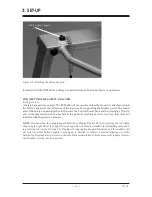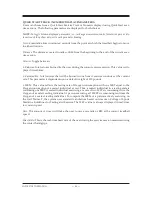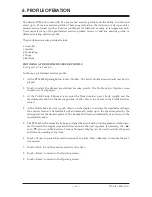
!
The following safety considerations should be observed for all patients who exercise on the
RTM 600.
1. All patients should consult a physician before beginning any rehabilitation program.
2. Instruct patient on proper use and all RTM 600 safety features before beginning exercise.
3. Always attach the Safety Lanyard to the patient’s clothing or wrist before allowing exercise to begin.
4. Ensure patient has stretched and warmed-up prior to starting exercise.
5. Do not allow any patient to exercise unattended on the RTM 600. Never leave the RTM 600 running
unattended.
6. Periodically monitor the heart rate of patients exercising on the RTM 600.
7. Begin all exercise at a slow pace, increasing speed gradually to patient tolerance and progressing toward
exercise goals. Always inform the patient immediately prior to increasing or decreasing speed or eleva-
tion.
8. If reversing belt direction, bring the RTM 600 to a complete stop and inform patient that the belt will
begin moving in the opposite direction.
9. Immediately discontinue exercise if patient feels faint, dizzy or short of breath.
10. Never allow anyone to step onto the RTM 600 while the treadbelt is in motion. Always stop the RTM
600 prior to allowing the patient to step up onto the treadbelt.
11. Instruct patients to use the handrails when first learning to walk on the RTM 600.
On devrait observer les considérations suivantes de sûreté pour tous les patients qui s'exercent sur
le RTM 600.
1. Tous les patients doivent voir leur médecin responsable avant d’entreprendre la séance de rééducation.
2. Expliquer au patient la bonne utilisation des systémes de sécurité du tapis avant de démarrer la séance.
3. Connector toujours la sangle de sécurité aux vêtements du patient ou poignet avant que le patient ne
commence à travailler.
4. Vérifier que la patient s’est échauffé et a fait des étirements avant de commencer l’entraînement sur le
tapis.
5. Ne pas laisser le patient seul sur le tapis pendant la séance. Ne jamais laisser le tapis tourner sans
patient et sans surveillance.
6. Surveiller de temps à autre la fréquence cardiaque du patient pendant la séance.
7. Démarrer les protocloes à une vitesse lente et augmenter progressivement la vitesse en fonction de la
tolérance du patient et progres uers les objectifs de la séance. Signaler avant de l’appliquer tonte aug-
mentation ou diminution de vitesse ou d’inclinaison.
8. Avant de changer la direction de déplacement du tapis, arrêter le tapis complétement et expliquer au
patient que le tapis va démarrer dans le sens opposé.
9. Arrêter la séance immédiatement en cas de dyspnée, d’étourdissements ou d’autres signes de malaise.
10. Ne jamais faire monter personne sur le tapis pendant que le tapis est en marche. Arrêter toujours le
tapis avant que le patient ne s’y positionne.
11. Donner la consigne au patient d’utiliser les barres horizontales lors de sa premiére séance sur le tapis.
2. SAFETY CONSIDERATIONS FOR GENERAL USE
— 2-1 —
CLINICAL CONSIDERATIONS FOR GENERAL USE
Содержание 950-284
Страница 13: ...Figure 5 2 The Exercise Track display Figure 5 3 The Numeric display CONTENTS 5 3 MANUAL OPERATION...
Страница 21: ......
Страница 27: ......
Страница 29: ......
Страница 40: ...13 1 ASSEMBLY DRAWINGS AND SCHEMATICS 13 ASSEMBLY DRAWINGS AND SCHEMATICS...
Страница 41: ...ASSEMBLY DRAWINGS AND SCHEMATICS 13 2 CONTENTS...
Страница 42: ...13 3 ASSEMBLY DRAWINGS AND SCHEMATICS CONTENTS...
Страница 43: ...ASSEMBLY DRAWINGS AND SCHEMATICS 13 4 CONTENTS...
Страница 44: ...13 5 ASSEMBLY DRAWINGS AND SCHEMATICS CONTENTS...






































